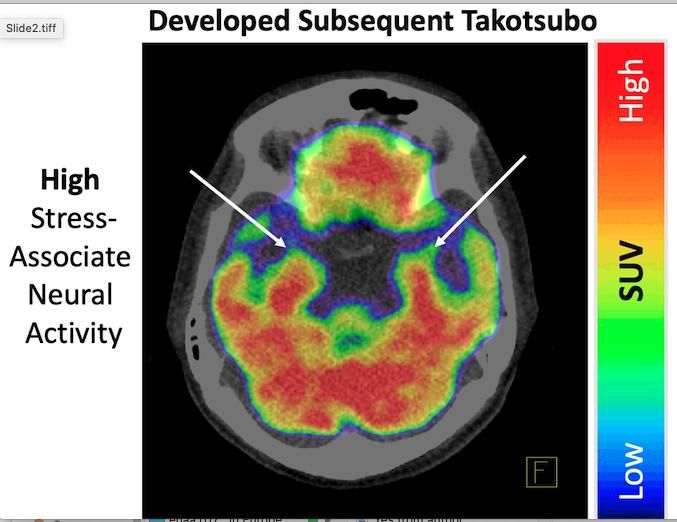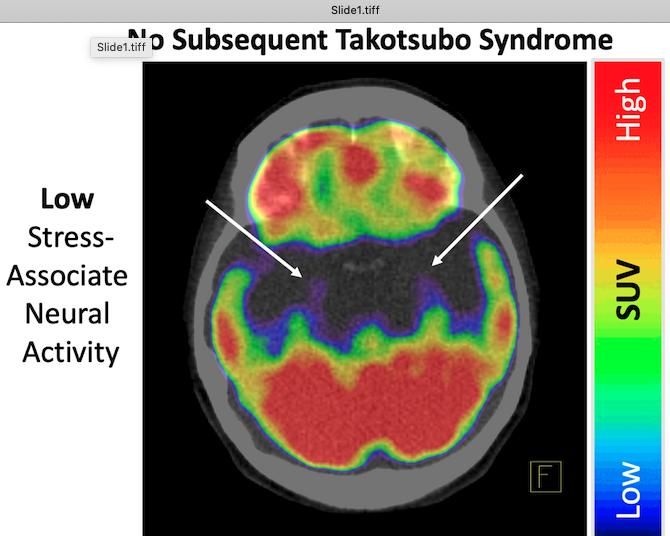PET/CT Reveals Potential Link Behind Broken Heart Syndrome
Increased stress-related brain activity in the amygdala can increase a patient's risk for Takotsubo syndrome.
“Broken heart syndrome” involves more than the heart itself. PET/CT has now shown that changes in the brain due to stress are a contributing factor to Takotsubo syndrome (TTS), a heart condition that is sometime fatal.
With these scans, providers can see the stress-related uptick of activity in the brain’s amygdala region that can increase a patient’s risk, said a team of researchers from Massachusetts General Hospital (MGH). Knowing more about this connection can help improve care for at-risk individuals.
Severe emotional distress, such as grief, anger, or fear, as well as happiness, can trigger the sudden weakening of the heart muscles that that cause the swelling at the bottom of the left ventricle while the neck remains narrow. All of these emotions originate in the amygdala, the brain region that also controls the heart and nervous system.
“We show that TTS happens not only because one encounters a rare, dreadfully disturbing event – such as the death of a spouse or child, as the classical examples have it,” said team leader senior author Ahmed Tawakol, M.D., director of nuclear cardiology and co-director of the Cardiovascular Imaging Research Center at MGH. “Rather, individuals with high stress-related brain activity appear to be primed to develop TTS – and can develop the syndrome upon exposure to more common stressors, even a routine colonoscopy or a bone fracture.”
Scan of brain in person who developed TTS.
Credit: European Heart Journal

TTS can cause heart attacks and death, and it is more common in women with only 10 percent of cases occurring in men. But, how does stress actually leads to TTS? Based on their investigation, the team believes they have pinpointed how the brain contributes. Kick-starting stress-sensitive tissues in the brain could be the first step, they said, because doing so releases stress hormones that ignite the sympathetic nervous system that emits inflammatory cells.
Scan of brain of someone who did not develop TTS.
Credit: European Heart Journal

“[Our] study suggests that the increased stress-associated neurobiological activity in the amygdala, which is present years before TTS occurs, may play an important role in its development and may predict the timing of the syndrome,” Takawol explained. “It may prime an individual for a heightened acute stress response that culminates in TTS.”
To determine if TTS patients experience brain activity changes, Takawol’s team examined PET/CT scans from 104 people with an average age of 68 imaged between 2005 and 2019. Women made up 72 percent of the group. It is the first study to use PET/CT to evaluate brain activity prior to the development of TTS.
According to their evaluation, 41 people went on to develop TTS between six months to five years after the scan, but 63 didn’t. For the entire group, the time between scan, TTS onset, and the last scan or death was, on average, 2.5 years.
The team found that patients who did develop TTS had higher stress-related activity in the amygdala on their first can that those who did not develop it – and the higher the amygdalar signal, the more significant the TTS risk. In fact, the top 15 percent of patients with the highest amygdala activity developed TTS within a year of imaging, they said.
Other factors also appeared to be at play in increasing a patient’s risk for TTS, including autoimmune disease, hyperlipidemia, smoking, and cancer.
In addition, Takawol’s team pinpointed a relationship between stress-related brain activity and bone marrow activity. This connection can be significant for cardiovascular health because bone marrow produces various types of blood cells that are involved with carrying oxygen, mounting immune responses, and clotting blood.
A link between the brain and the heart has long been postulated as an integral part of TTS development, said a team led by Hideaki Suzuki, an assistant professor at Tohoku University Graduate School of Medicine in Japan. Consequently, this study opens the door for further investigation into how best to reduce the brain’s stress-related activities.
“Heightened stress-associated neural activity may represent a therapeutic target to reduce TTS, as well as other stress-related cardiovascular diseases, including chronic heart failure,” said Suzuki’s team in an accompanying editorial.
Ultimately, Takawol said he hopes these findings will feed into that goal, leading to improved therapies, including drug interventions.
“Studies should test whether such approaches to decrease stress-associated brain activity decrease the chance that TTS will recur among patients with prior episodes of TTS,” he said.
For more coverage based on industry expert insights and research, subscribe to the Diagnostic Imaging e-Newsletter here.
GE HealthCare Debuts AI-Powered Cardiac CT Device at ACC Conference
April 1st 2025Featuring enhanced low-dose image quality with motion-free images, the Revolution Vibe CT system reportedly facilitates improved diagnostic clarity for patients with conditions ranging from in-stent restenosis to atrial fibrillation.
The Reading Room: Racial and Ethnic Minorities, Cancer Screenings, and COVID-19
November 3rd 2020In this podcast episode, Dr. Shalom Kalnicki, from Montefiore and Albert Einstein College of Medicine, discusses the disparities minority patients face with cancer screenings and what can be done to increase access during the pandemic.
Can Photon-Counting CT be an Alternative to MRI for Assessing Liver Fat Fraction?
March 21st 2025Photon-counting CT fat fraction evaluation offered a maximum sensitivity of 81 percent for detecting steatosis and had a 91 percent ICC agreement with MRI proton density fat fraction assessment, according to new prospective research.